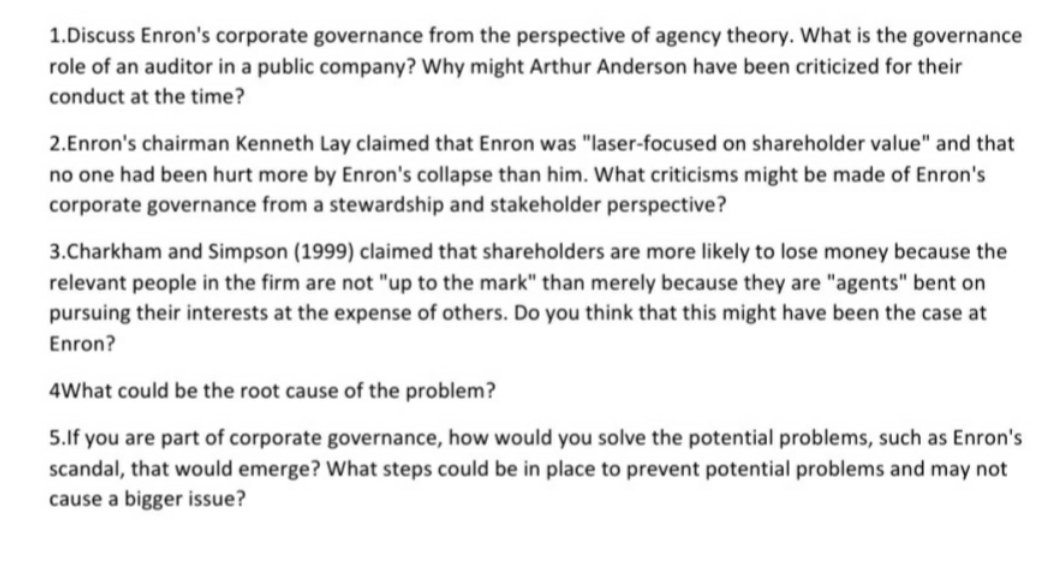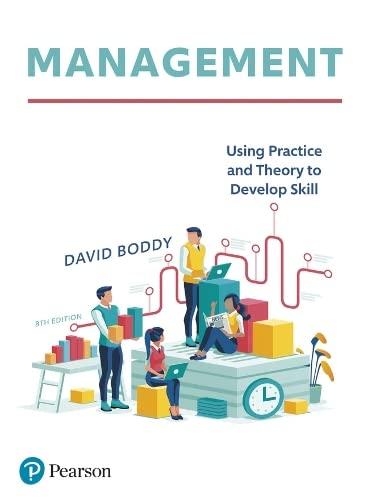Question
The Enron's Enron was founded in 1985 by its chairman Kenneth Lay as a natural gas pipeline company. In the newly deregulated gas industry, however,
The Enron's Enron was founded in 1985 by its chairman Kenneth Lay as a natural gas pipeline company. In the newly deregulated gas industry, however, gas producers and buyers could now trade, and hedge gas supplies, and Enron quickly moved to exploit the new opportunities afforded by this development. Under the direction of Jeffrey Skilling, then president of Enron's trading operations, Enron expanded into energy sectors in other countries, developing an increasingly influential role as a trading house for the energy industry. Using this model, Enron diversified into electricity, coal, paper, plastics, metal, and then with the establishment of Enron Online, moved into telecommunications bandwidth trading. By the late 1990s, Enron had secured a reputation for exceeding earnings expectations -- Fortune Magazine selected Enron as "America's most innovative company" for six straight years from 1996 to 2001.In 1992, however, Skilling convinced federal regulators to permit Enron to use an accounting method known as "mark to market." With mark to market accounting, the price or value of the security is recorded daily to calculate profits and losses. Using this method, Enron could count projected earnings from long-term energy contracts as current income. The money that might not be collected for many years and could be used to inflate Enron's revenue figures by manipulating projections for future revenue. The use of such "black box" accounting techniques was agreed to by Enron's auditor, Arthur Anderson, but made it difficult for outsiders to see how Enron made money.A series of special-purpose entities were also established by CFO Andrew Fastow to maintain the impression of sustained profits growth. Large debts amounting to billions of dollars could now be concealed in the financial arrangement Enron had with the special purpose entities (SPEs). Enron's auditors were aware of the new provisions and agreed that they were probably legal. When Enron's share price began to fall in 2001, however, its capacity to hide its losses began to diminish. In October 2001, Enron disclosed non-recurring charges of US 1.1billion,areductioninshareholder?sequityofUS 1.2 billion, and a US 700millionloss,therebyrevealingtothemarketthesignificanceoftheshadowySPEcompanies.Sixweekslater,Enron,whichhadUS 62billion in assets, filed for bankruptcy. Arthur Anderson would then also collapse, and over 20,000 Enron employees (many of whom had their superannuation invested in Enron stock) subsequently lost their jobs. By this time, Enron was acquiring an unsavory reputation not only for its accounting fraud but for the manner of its business operations. The operations of the energy market that Enron was at the center of caused a series of catastrophic power shortages and blackouts in California in 2000/2001 that significantly harmed the economy of the state. As Enron took advantage of the newly deregulated Californian energy market, rolling blackouts began. Before May 2000, electricity prices had averaged US 24?40permegawatt?hour;frighteningly,thepricethensurgedtothepricecapofUS 750 per megawatt-hour in June. Entire neighborhoods saw their power shut off for an hour to two hours at a time - at which point their power turned back on, and another neighborhood went dark. Small businesses had to shut their doors because they couldn't pay their bills. Schools had to send students home because their electricity shut off. Enron took full advantage of the price hike, booking profits of some $200 million just between May and August 2000. Enron accused of manipulating the energy market to its advantage, causing dramatic increases in the cost of power until the Federal Energy Regulatory Commission was forced to intervene.

Step by Step Solution
There are 3 Steps involved in it
Step: 1

Get Instant Access to Expert-Tailored Solutions
See step-by-step solutions with expert insights and AI powered tools for academic success
Step: 2

Step: 3

Ace Your Homework with AI
Get the answers you need in no time with our AI-driven, step-by-step assistance
Get Started


